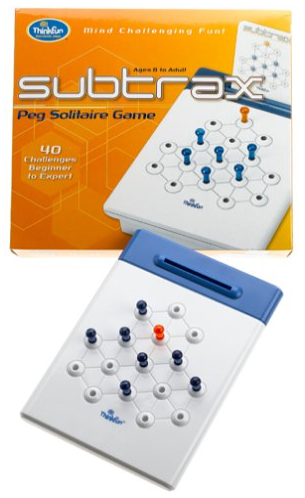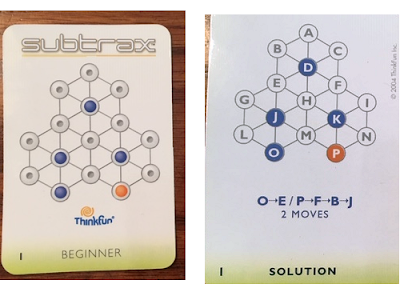 |
| Subtrax - A pegboard challenge. |
Self-contained in a plastic box that closes securely, this is a game that you could take almost anywhere. Measuring 7" x 5", the game pegs and challenge cards are stored inside and the playing board is the top of the box. The object of the game is to set up the pegs on the board according to a challenge card, then use one peg at a time to jump over other pegs until only the orange peg is left.
There are 15 pegs, 14 blue and 1 orange, and the challenges will use anywhere between 7 and all 15 pegs. Challenges will require anywhere between two and 10 moves to solve. Like checkers, you may jump more than one peg in a turn, and the orange peg may also jump the blue pegs.
There are 40 challenges total and they increase in difficulty as you go. Solutions are printed on the backs of the cards. Cards measure about 2 1/8" x 3 1/8". Here is the first challenge with solution and the last challenge with solution.
 |
| LEFT: Challenge #1 RIGHT: Solution |
 |
| LEFT: Challenge #40 RIGHT: Solution |
Object:
Solve all 40 challenge cards by jumping and removing blue pegs until only the orange peg is left.
Set up:
Choose a challenge card and place the colored pegs in the holes on the game board to match.
Play:
Choose a peg and jump another peg (or more). Remove the peg(s) that you jump. Pegs may only jump adjacent pegs in the directions indicated by the lines on the game board. You may only move by jumping another peg and landing in an adjacent open hole. You may not jump over more than one peg at a time or jump over an empty hole. No non-jumping moves allowed.
Check out other one-person logic games I have blogged about.
Try this:
- Play a few games by following the directions on the solution side of the card to get the feel and idea of how to play.
- Play a game while the individual watches. Talk through your thinking as you play so that they can learn the problem-solving process. Then set the same challenge up again and see if they can play alone.
- Use the orange peg and two or three blue pegs to demonstrate jumping before playing. Set them up so that you can jump them all in one move leaving the orange one left. This may be an easier way to learn about jumping without extra pegs on the board to confuse.
- Use the solution side only of the cards if an individual is not capable of playing. Set the board up as pictured and then follow the directions to complete the challenge. Or just use it as a puzzle to set up.
- Set up a challenge. You make the first move or two to help the individual get stated and see if they can finish it alone.
- Work on visual discrimination, spatial relations, visualization, eye-hand coordination, manual dexterity, fine motor skills, planning, logic, problem solving, process skills, executive functioning skills, play and leisure exploration and participation
If you are interested in purchasing this game or just want more information, click on the image below.







